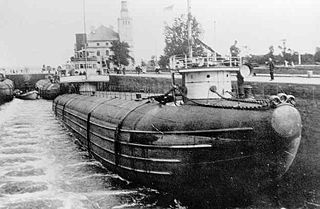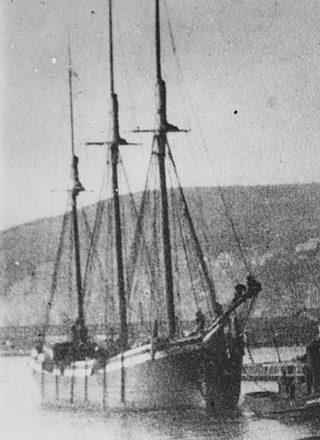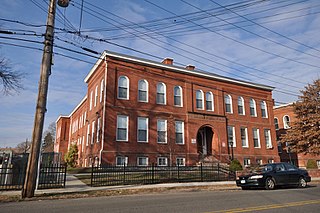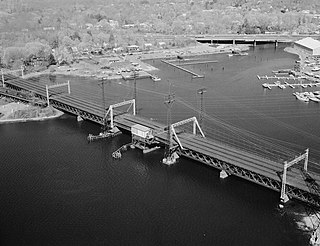
Harkness Memorial State Park is a historic preservation area with botanical garden and recreational features located on Long Island Sound in the town of Waterford, Connecticut. The state park's 304 acres (123 ha) center around Eolia, a 42-room Renaissance Revival mansion with formal gardens and greenhouses. The park is managed by the Connecticut Department of Energy and Environmental Protection.

This is intended to be a complete list of the properties and districts on the National Register of Historic Places in Fairfield County, Connecticut, United States. The locations of National Register properties and districts for which the latitude and longitude coordinates are included below may be seen in an online map.

Tongue Point Light Lighthouse, also known as Bridgeport Breakwater or Bug Light, is a lighthouse on the west side of the Bridgeport Harbor entrance, in the city of Bridgeport, Connecticut in the United States. Built in 1891 and moved to its present location in 1919, it was instrumental in the development of the city's inner harbor as a transshipment point connecticut rail and water freight transport systems. It was added to the National Register of Historic Places in 1990.

The Thomas Wilson was a whaleback freighter built in 1892 and used to haul bulk freight on the Great Lakes. The ship sank in Lake Superior just outside the harbor of Duluth, Minnesota, United States, on 7 June 1902, after a collision with the George Hadley. The wreck of the Thomas Wilson is one of the best remaining examples of a whaleback steamer, and it is also significant for the changes made in operating procedures at the Duluth harbor. The remains of the ship were listed on the National Register of Historic Places in 1992.

Priscilla is a classic oyster dredging sloop and museum ship at the Long Island Maritime Museum. Built in 1888, it is the oldest surviving boat from the Great South Bay oyster fleet, and was designated a National Historic Landmark in 2006. It is berthed near the Modesty, another National Historic Landmark sloop.

Luna is a historic tugboat normally berthed in Boston Harbor, Massachusetts. Luna was designed in 1930 by John G. Alden and built by M.M. Davis and Bethlehem Steel. She is listed on the National Register of Historic Places and is a U.S. National Historic Landmark. In 1985, the Luna was designated as a Boston Landmark by the Boston Landmarks Commission.

Samuel P. Ely is a shipwreck in Two Harbors, Minnesota listed on the National Register of Historic Places. She was a schooner that sailed the Great Lakes carrying iron ore, coal, and other bulk freight. She was built in 1869 and was a fairly typical example of the 200-foot schooner built in the 1870s, though she was reinforced for the demands of carrying iron ore.

The Maplewood School, also known as Grammar School No. 5, is a historic school building at 434 Maplewood Avenue in Bridgeport, Connecticut. It was built in 1893, and was designed by Longstaff & Hurd. It was built as part of a major program to improve the city's schools and provide for a rapidly growing population. It was listed on the National Register of Historic Places in 1990.

McLevy Hall is a historic municipal building at 202 State Street in downtown Bridgeport, Connecticut. The building was built in 1854 to house both the City Hall and the Fairfield County Courthouse, and served as Bridgeport City Hall into the 1930s. It was renamed McLevy Hall after Bridgeport mayor Jasper McLevy in 1966. The current city hall on Lyon Terrace was built in 1916, however municipal offices continued to occupy McLevy Hall through the 1970s. It was added to the National Register of Historic Places on September 19, 1977.

The Saugatuck River Railroad Bridge, also known as Saugatuck River Bridge, is a railroad bridge carrying trackage of Metro-North Railroad's New Haven Line over the Saugatuck River in Westport, Connecticut. It is one of eight moveable bridges on the Amtrak Northeast Corridor route through Connecticut. It was built in 1905 for the New York, New Haven and Hartford Railroad.

The Mianus River Railroad Bridge, also known as the Cos Cob Bridge, is a bascule drawbridge built in 1904 over the Mianus River, in Greenwich, Connecticut. It was listed on the National Register of Historic Places in 1987. The bridge carries the Northeast Corridor, the busiest rail line in the United States, both in terms of ridership and service frequency. It is operated by the Metro-North Railroad, successor to Conrail, Penn Central, and the New York, New Haven and Hartford Railroad, which erected it, and is owned by the Connecticut Department of Transportation.
The Sunken barges of Bridgeport are several ships sunk in Bridgeport Harbor, Bridgeport, Connecticut:
This is a list of the National Register of Historic Places listings in Greenwich, Connecticut.
Bridgeport Harbor is an inlet on the north side of Long Island Sound in Bridgeport, Connecticut. It was carved by the retreat of the glaciers during the last ice age approximately 13,000 years ago.

The Henry Chisholm was a wooden freighter; it was sunk off the shore of Isle Royale in Lake Superior in 1898 and the remains are still on the lake bottom. The wreck was placed on the National Register of Historic Places in 1984.

Elmer S. Dailey, originally known as the Claire B. Follette, is a wooden barge built by William H. Follette in 1915 at Tonawanda, New York, and rebuilt and renamed in 1928 by Brown Drydock on Staten Island, New York. It was used to transport materials from New York, New Jersey and Connecticut. It is the only known surviving Erie Canal boat and is one of a few remaining wooden-hulled canal boats. It sank in 1974 along with the Priscilla Dailey and the Berkshire No. 7 in the harbor of Bridgeport, Connecticut on the west side of the Pequonnock River. It has deteriorated to the point that a salvage operation could result in it breaking apart. It was added to the National Register of Historic Places on December 21, 1978.

Priscilla Dailey, previously known as the Elizabeth E. Newell, is a wooden canal boat constructed in 1929 in Whitehall, New York. The barge was used to transport bulk cargo in New York, New Jersey, and Connecticut harbors. It sank in 1974 along with the Elmer S. Dailey and the Berkshire No. 7 in the harbor of Bridgeport, Connecticut on the west side of the Pequonnock River. The sunken boat has deteriorated to the point that a salvage operation could result in it breaking apart. It was added to the National Register of Historic Places on December 21, 1978.

SS Robert Wallace was a wooden-hulled American bulk freighter that served on the Great Lakes of North America from her construction in 1882 to her sinking in 1902 on Lake Superior near the town of Palmers, St. Louis County, Minnesota, United States. On November 17, 1902 shortly after leaving Superior, Wisconsin with a cargo of iron ore, Robert Wallace sprang a leak and sank. Her wreck was found in 2006, and on October 14, 2009, the wreck of Robert Wallace was listed in the National Register of Historic Places.

SS Selah Chamberlain was a wooden hulled Great Lakes freighter that sank in Lake Michigan in 1886, 6 miles (10 km) off the coast of Sheboygan, Sheboygan County, Wisconsin, United States after being rammed by the steamer John Pridgeon Jr. with the loss of five lives. On January 7, 2019, the wreck of Selah Chamberlain was listed on the National Register of Historic Places, and was given the reference number 100003288. She was the first shipwreck listed on the National Register of Historic Places in 2019.


















